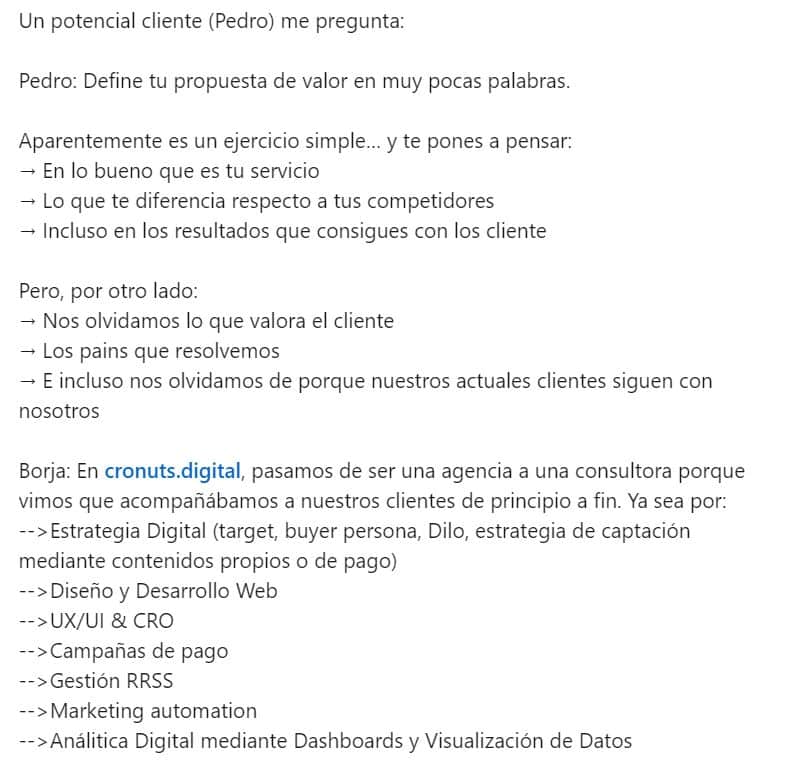It is very common to hear about the concept of social selling and more specifically if we refer to Linkedin. In fact, nowadays everyone is talking about creating a personal brand by sharing quality content and adding value to our network. In this article, we have tried to bring together what we at CRONUTS consider to be social selling in particular on the LinkedIn platform.
Today’s sales have evolved. In fact, we could say that it has changed. Our potential customers are no longer looking for salespeople, they are looking for help. Therefore, you should not try to sell but to be bought, that is to say, to do social selling. In order for them to buy from you beforehand, you have had to help them in some way. The following points should be taken into account:
- Share quality content that will help your potential customers
- Join the Linkedin groups where your potential clients are located
- Customize your connection requests
- Have conversations that add value
- Try to take conversations outside Linkedin.
-
Share valuable content
First, you need to share valuable and engaging content that is relevant to your ideal customer.
You can share your own or your company’s content, relevant insights from industry thought leaders, or a combination of both. Your goal should be to share information that helps or solves the main challenge or problem that your potential customers want to overcome.
When your ideal clients or prospects see relevant content, they identify with it and somehow put a first and last name to you. This step is essential for “cold” sales. It is not only about sharing valuable content but also about having a certain recurrence. Today, we are constantly impacted by companies on all networks, “telling” us how good their services are. But on LinkedIn, something different happens: it’s the people who speak, not the companies. That is why this channel is ideal to make yourself known, always providing value to your potential customers.
Additionally, the frequency with which you provide value is very important. If you combine both characteristics, value and frequency, you will get customers. Perhaps not in the short term, but in the medium and long term.
Example: as a digital consulting firm, we know that our clients have problems with aggregating data from different sources, especially in marketing. We know that this person when he gets to the end of the month his boss asks him about the data and he has it in 5 different documents and it is always a chaos… If we bring value by post about data studio “a good tutorial” or even better we create a data studio where you just have to change our data sources for yours and see the aggregated results.
We know that we clearly make a difference. We have solved a real problem and if this potential customer has a need, he will keep us in mind.
Or if we send you a message because you have interacted with one of our posts, the message will not be so cold.
-
Join relevant linkedin groups to grow your network
By joining LinkedIn groups, you can expand your potential reach and LinkedIn network, making it possible for group members to connect with you and view your profile even if you don’t have mutual connections.
Within groups, you can use the search function to filter members by job title, geographic location and industry, making it easy to find your ideal customers.
Look for groups to which your potential customers belong and are active and engaged members. This makes it easier to send a first request message.
-
Customize connection requests
When sending connection requests to potential customers or people you don’t know personally, it’s critical to include a personalized message. By sending a custom request you provide the context necessary to explain to this person why they should add you, and can help you versus typical generic requests.
Here are some points you could include:
- A personalized greeting with your name → beware that nowadays there are robots that already do it.
- Mutual connections (if applicable) → can be done by a robot.
- Mutual groups (if applicable) → can also be done by a robot.
- Content they engaged with → Good point.
- Experience in their profile that caught your attention → good point.
Today there are plenty of robots that can do the first three types of tasks, so it is essential to provide quality value and differentiate yourself. A simple invitation is less likely to be accepted.
-
Facilitating meaningful conversations
Once you connect with a prospect on LinkedIn, keep the conversation going. Ideally, don’t make the sale right away, you’ll want to keep in touch to stay in their sights.
The personalized message you send when you make your connection request can be a good conversation starter.
You can also keep the conversation going by participating in their posts and sharing content that may be of interest to them. This is very relevant because we are used to engage in conversations with our own posts but then we are not able to interact with the posts of our potential customers. Remember, it is important to provide value and maintain the frequency and what better than to provide value in a post of your potential client…
-
Take conversations outside linkedin
After engaging in several conversations or messages with your potential customer, you need to look for an exit door. An exit door basically takes the customer off the platform. Here are some examples:
- Propose the download of an ebook on your website in order to have the email → aggressive
- Use tools such as snov.io to find out your corporate email → very aggressive.
- If they have any questions about a document you may have shared, provide them with your contact information via a link where they can book a call for you. (this can be done with the calendly tool or google I also allow it
Social selling on LinkedIn: Examples
How to start selling on social networks directly from your profile? Let’s take a look at examples of top companies and marketers on LinkedIn.
- Open question
What better way to generate engagement on one of your posts than by asking a question?
Better yet, why not ask a question that speaks directly to your target audience?
It’s very interesting how HubSpot tries to empathize with their potential buyer personas through a situation they know they have experienced.
This position is effective because:
- Marketing managers are their target
- With this question they come to understand their challenges
- Thought-provoking: it is not a question that can be answered with a simple yes or no answer.
Following this example, try to ask a question that addresses the type of people you would like to sell to. Once you get a few comments, be sure to respond, continue the conversation and connect.
Example Cronuts:
Message: The end of the month is coming and you have to present the results of your marketing campaigns. What tools do you normally use?
Everyone you answer can make a recommendation that will be useful to them. If they tell us that they use Excel, you can tell them that the same Excel can be passed to Data Studio, for example.
-
Article
The list-icules work and are easy to generate. It is best to touch on topics that your potential client can relate to.
In this example, in this article we see that the author detects that part of his network has the wrong url and that it must be changed in order not to be misperceived. It also provides a list of tips and in detail an article with best practices. We bring value so that people take us into account.
- The intellectual leadership position
In this example, a career coach explains how to deal with a specific situation in a selection process. She is dedicated to guiding professionals to make the best employment decisions. It talks about a very concrete situation that at some point has happened to all of us.
In this way, you provide a resource to make your potential customers get what they want.
-
Launching of resources
Offering something free that really adds value is key to generating awareness. In this social selling example, we talk about how to close sales that are initiated on linkedin. If you are interested in this topic and its content, please comment on the post to obtain the document. This improves the author’s visibility. Additionally, in order to send you the document, they may ask for your email address, so they already have another channel to reach you.
- The inspiring story
In this example, a Cronuts professional shares a conversation he had with a customer. End the story with a positive and thought-provoking comment in order to stay in the minds of your potential customers/readers.
While inspirational stories seem to be everywhere on LinkedIn lately, there’s nothing wrong with them; in fact, a little positivity can do a lot to brighten your prospects’ day. It is especially effective if the message is related to your problems or your day-to-day life.
In short, what should be taken into account for social selling on Linkedin?
If we assume that the sales process has changed. It’s not like it used to be. We are not looking for salespeople; the range of products and services is wide enough that we don’t have to look for them. That is why we have to highlight. How can we do it? Differentiating ourselves, i.e. you should not seek to sell but to be bought, and for this you must carry out social selling.
Taking into account the above mentioned:
- Increase your network according to your potential customers
- Customize the invitation messages. Don’t even think of selling at first. If you are lucky and he accepts you, he will create valuable content to make the next interaction more commercial.
- Share valuable content that really helps you
- Engage them in conversation. Not only in your posts, but also in theirs.
- To the extent you can, try to take the conversation outside of LinkedIn.
Think about helping and not selling. If you do it this way, the sale will happen by itself.
If by any chance you are looking for an agency that helps you on Linkedin you can visit our page and find out about our services.











